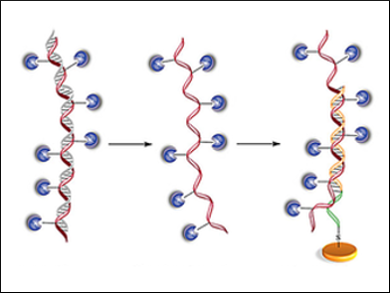The incorporation of redox-labeled nucleotides (deoxyribonucleoside triphosphates or dNTPs) is a useful technique for DNA sensing applications. Usually, this involves amplification of a target DNA via polymerase chain reaction (PCR). Redox-labeled nucleotides can be detected using electrochemical techniques. While incorporation of organic molecules to dNTPs has been done since the 1990s, it was only recently that organometallic moieties were used, mostly due to issues of thermal stability and steric hindrance.
Ciara O’Sullivan, Universitat Rovira i Virgili, Tarragona, Spain, and Institució Catalana de Recerca i Estudis Avançats (ICREA), Barcelona, Spain, Bernold Hasenknopf, Sorbonne Universités, Paris, France, and colleagues have synthesized polyoxometalate-deoxynucleotide (POM-dNTP) bioconjugates. POMs are nanometer-sized transition metal oxide clusters that can undergo multiple electron-transfer steps and have a variety of applications in catalysis and medicinal chemistry.
The team evaluated whether these POM-dNTP conjugates can be used for PCR. They optimized the conditions in such a way that they could detect the presence of a target DNA sequence using both electrophoretic methods and electrochemical methods. Their target sequence included DNA from Yersinia pestis, a deadly microorganism responsible for the bubonic plague. The team was able to improve the detection limit of this DNA sequence compared to previous studies to around 0.3–1.7 nM.
- PCR Incorporation of Polyoxometalate Modified Deoxynucleotide Triphosphates and Their Application in Molecular Electrochemical Sensing of Yersinia pestis,
Mayreli Ortiz, Ahmed M. Debela, Marketa Svobodova, Serge Thorimbert, Denis Lesage, Richard B. Cole, Bernold Hasenknopf, Ciara K. O’Sullivan,
Chem. Eur. J. 2017, 23, 10597–10603.
DOI: 10.1002/chem.201701295




